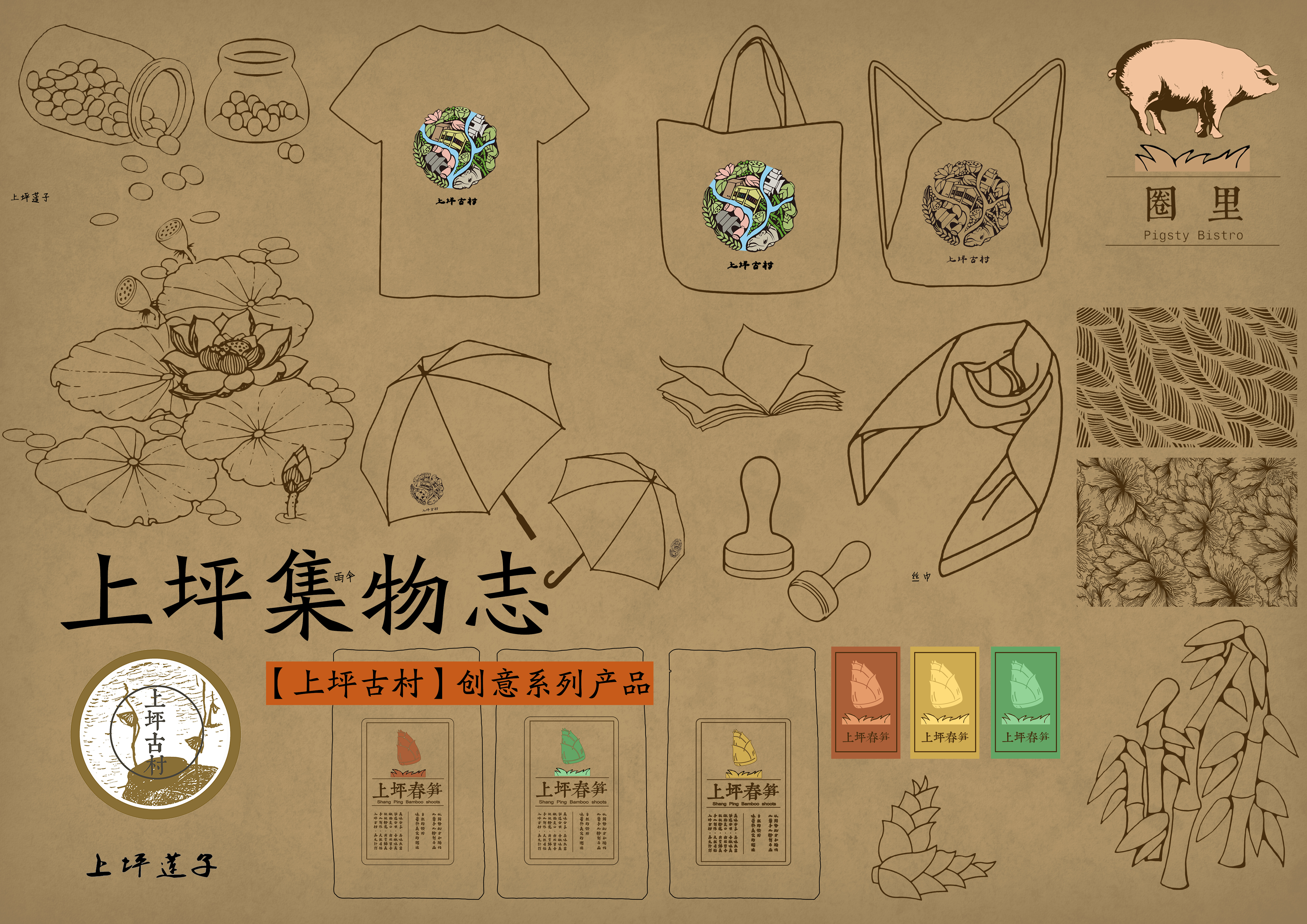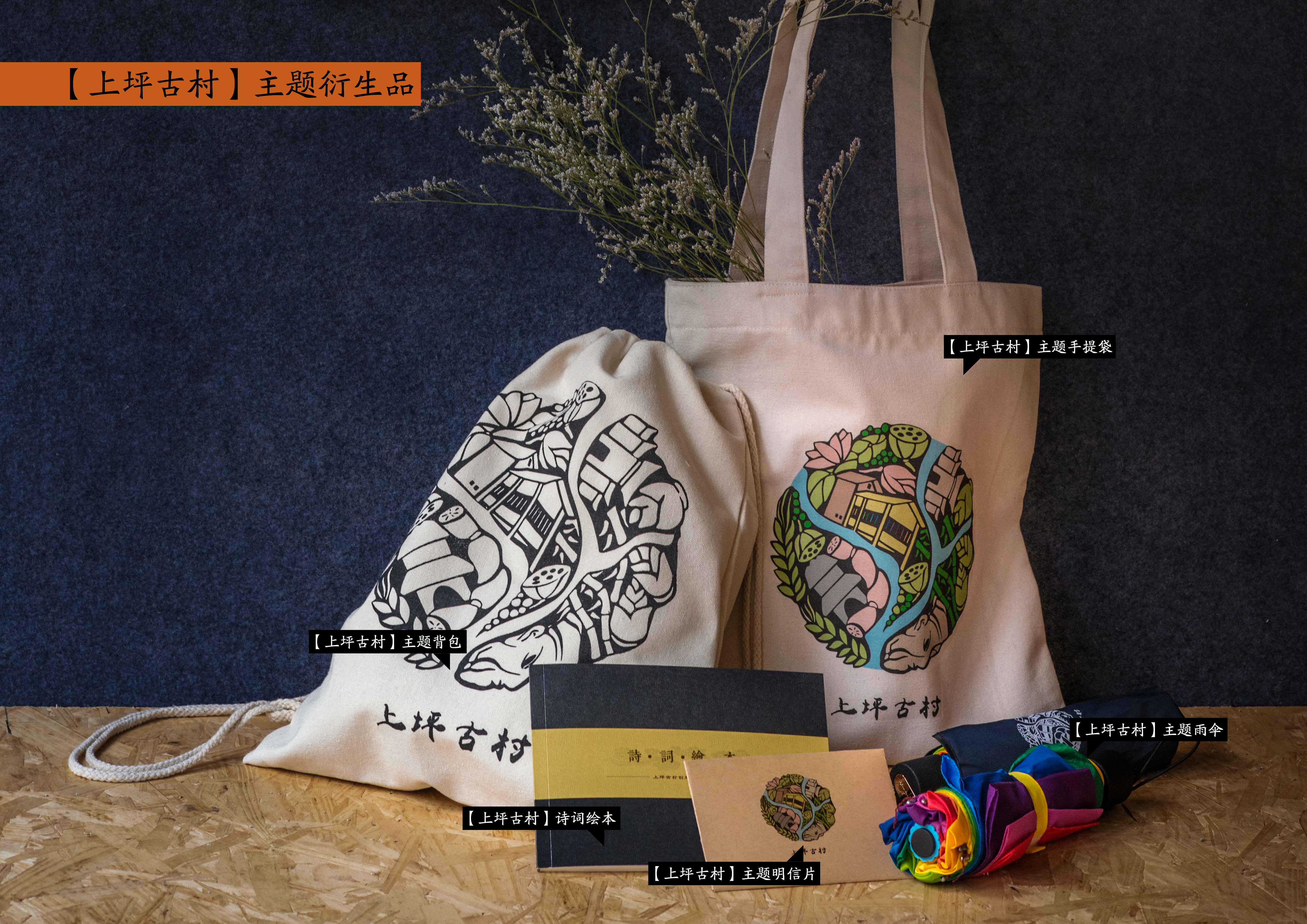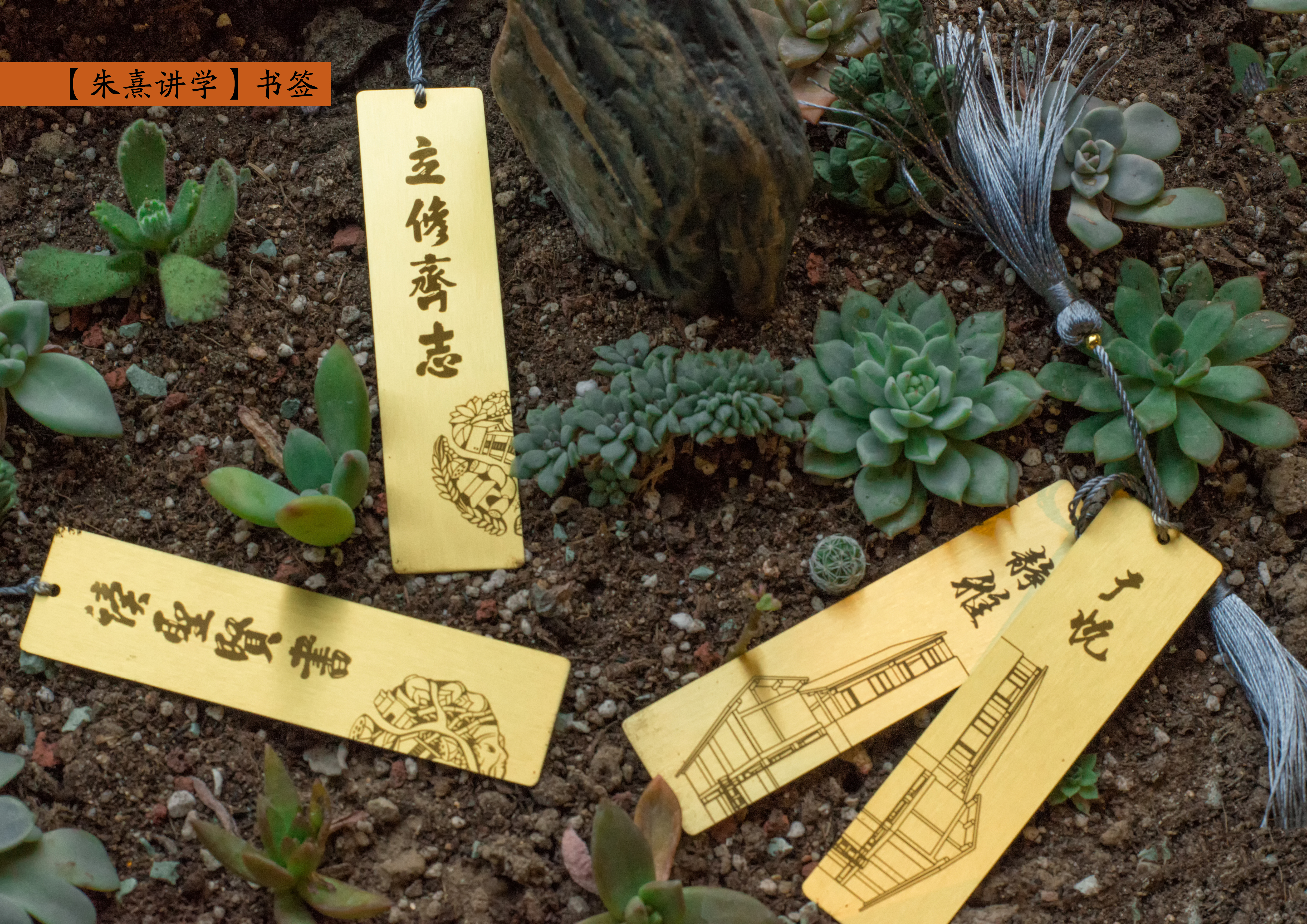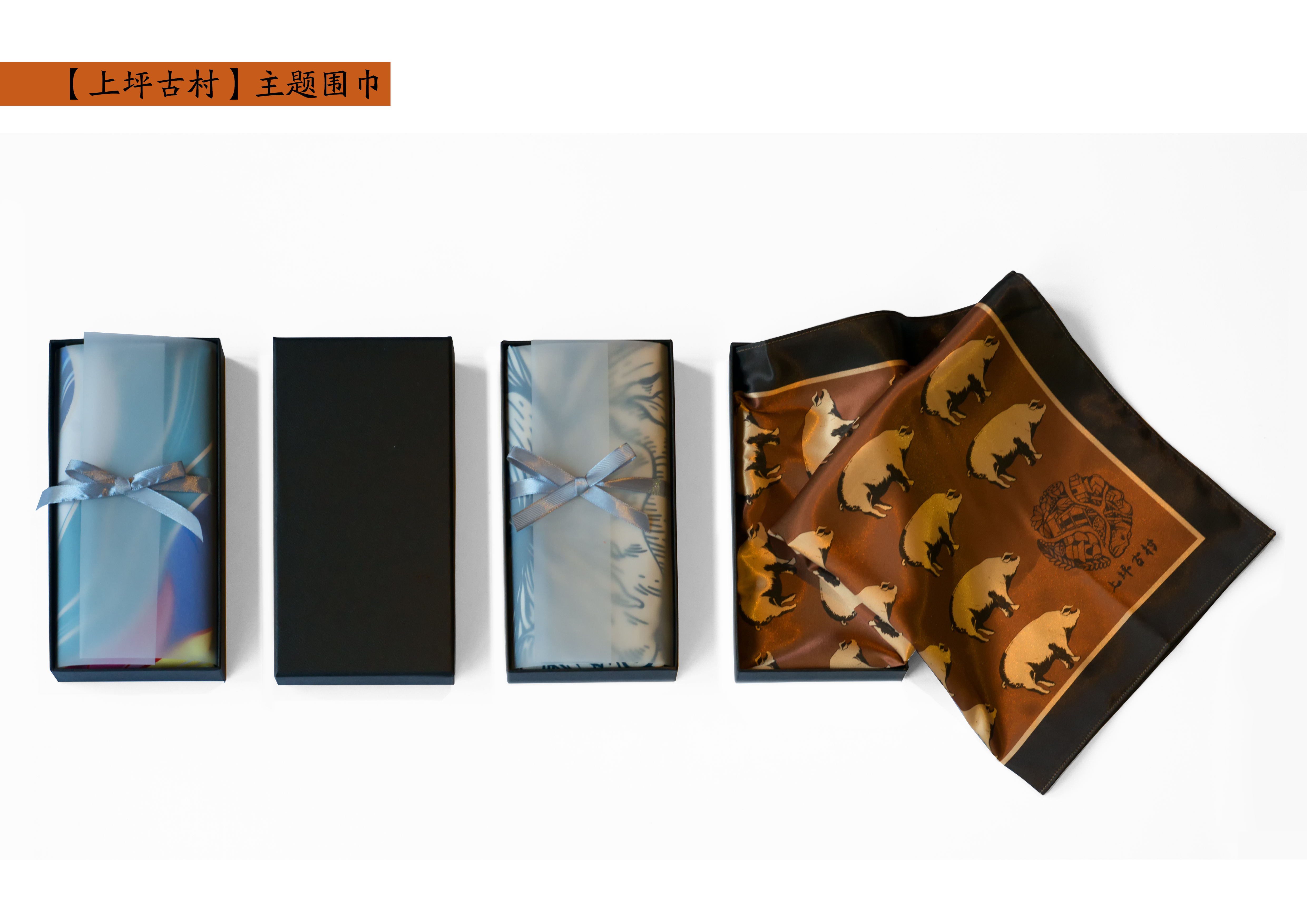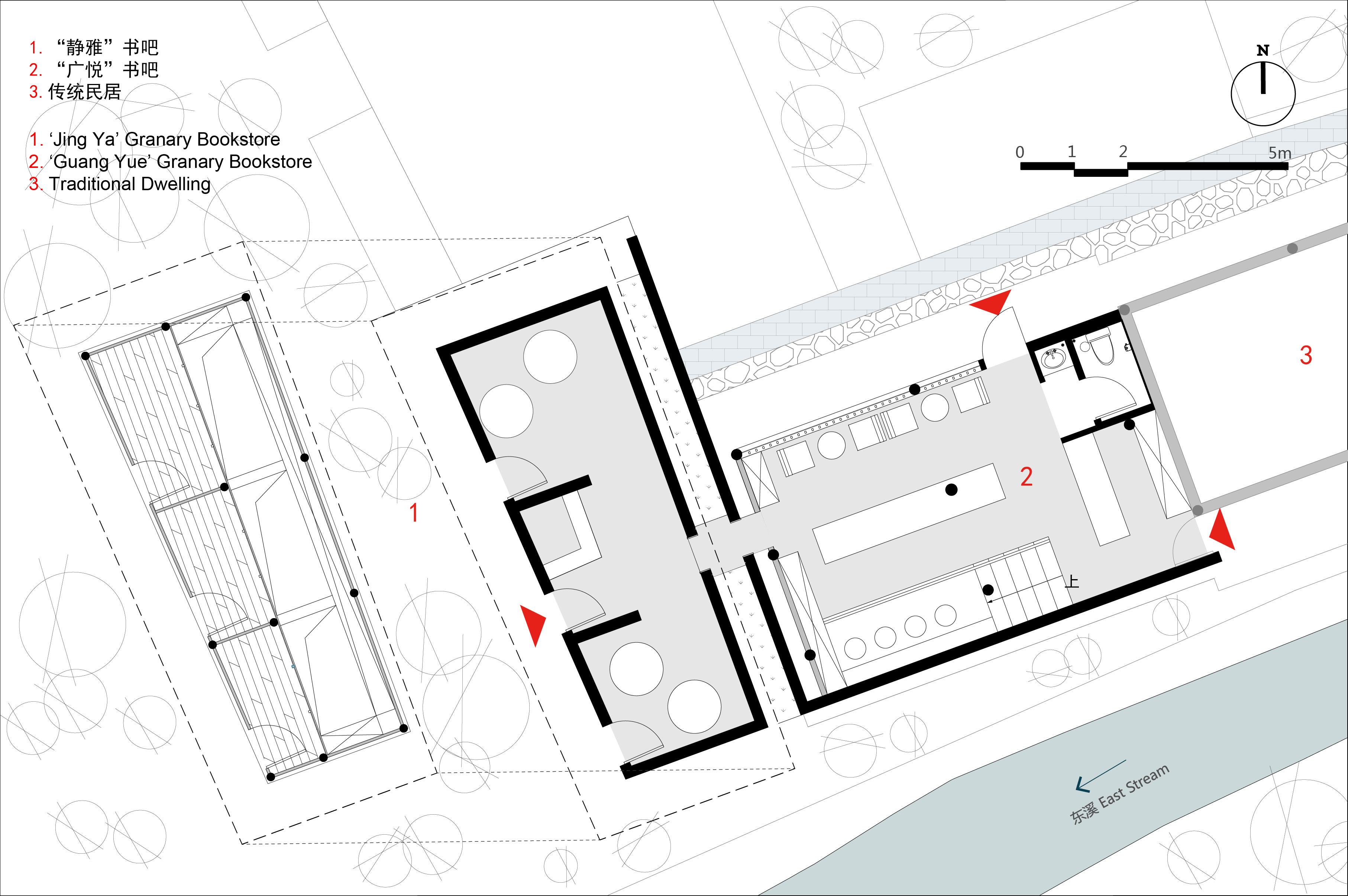杨家学堂节点位于上坪村两条溪流的交汇处,是入村后的道路分叉口,地理位置非常重要。此处有杨家学堂,相传朱熹曾在这里讲学,并留下墨宝。选择在这个地点进行节点改造设计,既考虑了旅游人流行为的需要,也照顾到了上坪古村的历史文化。
Yang’s School Area is located at the intersection of the two streams in Shang Ping Village where two main trails dispatch from the entrance. That’s the reason of being important geographically. According to historical legend, Mr. Zhu Xi, a national historian and educationalist, has lectured in Yang’s School and created great poems as well as calligraphy here. The design of this part is to transform historical site into a tourist spot and unveil the great history of Shang Ping Village.

 改造对象是杨家学堂外面的几间废弃的农业生产用房。他们是:杂物间、牛棚和谷仓。设计团队希望将原来的建筑改造为一个书吧,一方面为外来的观光者提供一个休息和了解村庄历史文化的地点,更为重要的是为当地人,特别是孩子提供一个可以阅读,可以了解外面世界的窗口,并为重拾“耕读传家”的文化传统提供了支点。
改造对象是杨家学堂外面的几间废弃的农业生产用房。他们是:杂物间、牛棚和谷仓。设计团队希望将原来的建筑改造为一个书吧,一方面为外来的观光者提供一个休息和了解村庄历史文化的地点,更为重要的是为当地人,特别是孩子提供一个可以阅读,可以了解外面世界的窗口,并为重拾“耕读传家”的文化传统提供了支点。
The design includes a few deserted agricultural buildings, such as utility rooms, cowsheds and barns. The design team hopes to transform the original buildings into a bookstore which provides space for tourists to learn about the history and culture of the village. Meanwhile, it also provide locals, especially children, with a place to get knowledge from the outside world. It is a great opportunity to indicate a well-known Chinese tradition called “Cultivation and reading is to bequeath to the family”.
广悦与静雅 ‘Guang Yue Granary Bookstore’ and ‘Jing Ya Granary Bookstore’
在前期的踏勘中,设计师发现现状的杂物间和牛棚在空间上有很大差异。杂物间相对高大,内部空间开放;而牛棚则正好相反,因为原有功能的需要,空间矮小,黑暗,几个牛棚之间由毛石分隔,此外牛棚上面还有一个低矮的二层用于存放草料。
In the early phase of site analysis, designers found that utility room and cowshed are very different in terms of spatial identity. The utility room is relatively tall with accommodated interiors , while the cowsheds are lower and darker. Several cowsheds are separated by rubble walls and second floors are used for storing forage originally.
空间的差异和“瑕疵”带来了空间改造的困难,同时也为改造后的建筑叙事提供了戏剧性元素,这正是改造项目有趣的地方。利用原有空间的特点,设计团队将新建筑定义为“一动一静”两个部分。
Spatial differences and ‘flaws’ bring about the difficulty of retrofitting these existing spaces. In the mean time, it seems to be a dramatic element for reforming architectural narrative, which is just an interesting moment for the project. By using the characteristics of the original space, the design team defined the new building as a combination of ‘Live and Calm’ .
“一动”是利用杂物间改造的书吧的售卖部分,这里相对热闹,拿书借书,买水喝水,以及设计团队专门为上坪村创作的一系列文创产品都在这里集中展示、销售。这里是上坪村对外的一个窗口,外来人可以在这里阅读上坪古村的“前世今生”;村里人也可以透过物理性的窗口(建筑的朝向村庄一面采用了落地玻璃的方式,将书吧和村庄生活连着一起。)和心理的窗口和外面的世界进行对话。大家称之为“广悦”。
‘Live’ refers to the sales space in Boostore transformed by utility room. It is relatively active to be here when exchanging books and sales activities happen periodically. Also, cultural products designed by the team are sold at this corner. Reading Bar is regarded as a cultural window connecting the village to the world outside. Visitors can get to know more about the village while local residents see the outside from a physical window(a full height glass door facing to the village ) and psychological one. It is called ‘Guang-Yue Granary Bookstore’ .
原有建筑朝向溪流一侧是封闭的毛石墙,开窗很高,但溪流和对面的田园景观又是希望引入书吧的。设计师并没有降低原有窗口,而是在室内加设了一个高台,人们需要走上高台才能从窗口看到外面。这样做一方面尊重了原有建筑与溪流、道路、村落的关系,保持了建筑内部和溪流之间“听水”的意境,另一方面也满足了人们登高远望的要求,也丰富了室内空间。建筑面向村庄的一侧,原有的围墙已经倒塌,设计师利用一面落地玻璃来重新定义建筑与村庄的邻里关系,也改善了原有建筑采光相对不理想的问题。
In the opposite of the building, the original surface across the stream is a solid wall with a high window on it. However, the landscape is so nice to be seen from the building that designer added a platform inside, on which people enjoy the view. This design principle maintains the existing relationship between interior and exterior. Thus, when people stay inside, stream is kept invisible for enjoying sound only. If visitors still wants to see the stream, one step on the platform makes it a great difference. A full-height glass window is embedded in the other side of the building to generate a new relationship with its’ neighbor, the village, to provide a great solution for better natural lights.
“一静”是读书、静思的空间,称之为“静雅”。它由牛棚改造而成。设计师认为原有建筑最有意思的空间模式是上下两层相互独立又联系的结构:下面为牛生活的地方,由毛石磊筑而成,狭小、黑暗;上面是存放草料的地方,木结构,同样狭小,相对黑暗;上面的“木房子”是直接放在下面的石头围子墙上的,它们之间在物理流线(上面的空间不会通过下面的空间进入)上是分离的,但在使用逻辑(牛吃草)上是关联的。
‘Calm’ refer to reading and meditation, named ‘Jing-Ya’. It is transformed from former cowsheds. The identity of this space, connected but separated from top to bottom, is special to be kept. The lower level enclosed by rubble used to be dark and narrow living space for cow, while narrow wood-made upper level were used for forage. Wood structure seats on rubble part. Two levels are separated spatially (entrance are separated) but connected logically (cow on the bottom eats forage)in function.
沿用了这个空间模式,但将上面的“木房子”稍微抬起,一方面增加下面空间的高度,另一方面将阳光引入原本黑暗的牛棚,这里将成为阅读者的新窝,安静、封闭,不受外部的干扰,唯一能打扰你读书的是从两层空间之间缝隙射入的一缕阳光。原有的毛石墙面被保留,懒人沙发被安置在地面上,柔软对应强硬,温暖对应冰冷,“新居民”对应“老住户”,戏剧性的冲突在对比中产生。二层的草料房被重新定义:原来的三个隔离的空间被打通,草料房的一半空间被吹拔取代,在吹拔空间与新草料房之间采用了阳光板隔墙,形成了半透明的效果;草料房仍然很低矮,进入的方式也必须从户外爬梯子而入,很是不舒服,但这也是设计师有意为之。设计师希望这里的使用回到一种“慢”的原始状态,有点类似苦行僧的状态,使用者需要小心的体味身体与空间,把都市的张扬收起,在读书中反思人与自然,人与环境的关系。
Maintaining this spatial character but elevating the upper ‘wood house’, it turns out to be a new home for readers since first floor is higher and gets more natural light. Nothing could disturb this quiet and enclosed space except the penetrated sunlight. The solid rubble wall on the first floor were maintained, contracting with cosy bean bag. Soft versus hard, warm versus cold and new versus old are co-existing in a dramatic space. The second floor was re-defined accordingly: three rooms are integrated into one with an atrium up to half size floor area. Glass panels are installed over the atrium to create more transparency. The forage room is still designed to be lower in height and must be entered from the outside by a ladder. This kind of ‘uncomfortableness’ is intentionally emphasized, creating a sense of slow and primitivity. The design is trying to allow people to get a monkish experience, to experience the space with cautiousness. Thus, all readers come to here would retrospect the relationship between human, space and nature without any disturbance of modern life.
这种“慢”的要求也同样反映在一静一动两个空间的连接位置上。一个刻意低矮的过道被设计出来,成年人需要低头弯腰慢慢通过。设计师希望通过这种空间的处理暗示“谦逊”这一中国民族的传统美德:低下头,保持敬畏。
The requirement of “Being Slow” is also revealed at the hallway. When being here, visitors should walk slowly through it to the other side. This intentionally designed lower space is to indicate a “modest” tradition in China: Bow your head and be in awe.
文创产品 Cultural and Creative Products
书吧也是上坪文创的重要展示和销售的聚点。设计师利用上坪古村原有的文化历史传说、传统进行乡村文创,打造一系列专属于上坪古村的乡村文创产品和旅游纪念品。如利用朱熹的墨宝对联创作的书签,笔记本;提取上坪古村的历史、文化、建筑、农业特点设计的上坪古村的logo,以及由此延伸的文化衫,雨伞等。这些文创产品既传承了上坪古村的历史文化,又为村庄旅游提供收入。
Bookstores are spots for cultural and creative industries in Shang Ping Village. Designers created multiple cultural products and souvenirs by taking advantage of history, legend and local materials. A good example is the design of notebooks and bookmarks, with couplets from Mr. Zhu Xi. The Logo of Shang Ping Village were designed with cultural, architectural and agricultural components. Other cultural projects, such as T-shirts and umbrellas, also derived from the logo. All these products inherit great culture of Shang Ping Village as well as increase local income from tourism industry.
▲Logo
▲书吧平面图
▲总平面图
项目信息——
项目名称:上坪古村复兴计划之杨家学堂篇
业主:溪源乡人民政府
主持建筑师:何崴
建筑设计团队:赵卓然、李强、陈龙、陈煌杰、汪令哲、赵桐、叶玉欣、宋珂
设计面积:113平方米
设计时间:2016年8月-2016年11月
建造时间:2016年11月-2017年12月
照明设计:清华大学建筑学院张昕工作室
照明设计团队:张昕、韩晓伟、周轩宇、牛本田
室内施工图设计:北京鸿尚国际设计有限公司
摄影:周梦
Project Information——
Project Name:Yang’s School Rural Library and Bookstore
Location: Xiyuan Town, Jianning County, Sanming City, Fujian Province, China
Client: People’s Government of Xiyuan Township
Architectural Design Company: 3andwich Design / He Wei Studio
Principal Architect: He Wei
Architectural Design Team: Zhao Zhuoran, Li Qiang, Chen Long, Chen Huangjie, Wang Lingzhe, Zhao Tong, Ye Yuxin, Song Ke
Building area: 113 sqm
Period of Design: Aug 2016 – Nov 2016
Period of Construction: Nov 2016 – Dec 2017
Lighting Design: Zhang Xin Studio, Tsinghua University School of Architecture
Lighting Design Team: Zhang Xin, Han Xiaowei, Zhou Xuanyu, Niu Bentian
Interior Construction Drawing: Hongshang Design
Photographer: Zhou Meng





















